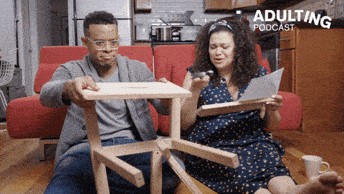- Partner Science, a Reel Axis Experiment
- Posts
- I hate IKEA furniture (but love their partnership secret)
I hate IKEA furniture (but love their partnership secret)
Plus: The Co-Creation Opportunity Analyzer

I have a confession: I'm Swedish, and I absolutely despise building IKEA furniture (I know, I know—my passport is probably being shredded as we speak).
Those "simple" instructions? More like a cryptic treasure map. Those "extra" screws? Oh dear, they're never extra. That "helpful" Allen wrench? My arch-nemesis in metallic form.
But plot twist: my furniture-building trauma just unlocked the holy grail of partnership strategies.
The Science of "I Built It, Therefore It's Awesome"
Back in 2012, some brilliant minds at Harvard (because apparently, studying furniture assembly is a thing in the Ivy League) discovered something wild: people get ridiculously attached to things they partially create themselves. They named it the IKEA Effect, because academics have a flair for the obvious.
And it works...
Even if the end result is wobblier than a three-legged chair
Even if they cursed in languages they didn't know they spoke
Even if they swear they'll "never do this again" (narrator: they will)

Why This Is Partnership Gold
Think about it:
Traditional approach:
"Ta-da! Here's our perfectly built solution!"
Partners eye it suspiciously like I eye IKEA manuals
IKEA Effect approach:
"Let's build this masterpiece together!"
Partners defend it like my neighbor defends his tilted bookshelf
The Psychology Behind It (No Assembly Required)
When partners help build something:
Their brain goes all "I made this!" like a proud toddler with a crayon masterpiece
They develop ownership stronger than my grip on that cursed Allen wrench
They'll defend it like it's their firstborn (or last piece of chocolate)

Turn Your Next Solution Into a Building Project (Minus the Frustration)
1. The Assembly Points Strategy
Keep 80% of your solution rock-solid (unlike those mysterious IKEA shelf supports)
Let partners design the crucial 20%
Magic words: "This is where your expertise makes this unbeatable" (works better than "the instructions say Tab A goes into Slot B... somewhere")
2. The Workshop Blueprint
Skip the death-by-PowerPoint approach. Instead, try:
2-hour building sessions (way more fun than actual furniture assembly, I promise)
Real-time customization (no Allen wrench required)
Partner-led decisions (because nobody likes being handed a manual and abandoned)
3. The Co-Creation Rules
No cryptic instructions
No mysterious extra components
No need to learn Swedish curse words (although they are quite colorful–jävla skit också!)
Your "No Allen Wrench Required" Action Plan
This Week:
□ Pick one solution begging for partner fingerprints
□ Mark 3 spots where partners can make it their own
□ Draft a workshop plan that doesn't require an engineering degree
Next Week:
□ Run your first building session
□ Document partner contributions
□ Celebrate their expertise (Swedish meatballs optional but recommended)
The Scientific Proof (Because Science Makes Everything Legit)
That Harvard study? It found that people value their wobbly creations more than perfect pre-built ones. Unlike IKEA's "30-minute assembly time" estimates (ha!), these findings are actually peer-reviewed.
AI Learning Lab: The Co-Creation Opportunity Analyzer
Want to turn your existing solutions into perfect co-creation opportunities? Let's get AI working for you.
Feed your product documentation, feature lists, and partner feedback into your favorite AI tool with this prompt:
Analyze our solution and identify:
1. Components that could be modularized for partner customization
2. "Assembly points" where partners could add unique value
3. Potential risks if certain elements are modified
4. Recommended "guard rails" to ensure solution integrity
Then, for each identified opportunity:
- Rate complexity (1-5)
- Estimate partner effort required
- Suggest specific workshop activities
- List required resources/supportThe bottom line, your solution doesn't need to be as confusing as IKEA instructions. But according to science (and my furniture-building PTSD), it does need partners' fingerprints all over it.
Because while I'll never enjoy building IKEA furniture (sorry, motherland), the research is crystal clear: people value what they help create.
Even if there are a few screws loose in the process (and trust me, there will be screws loose. There are always screws loose).
